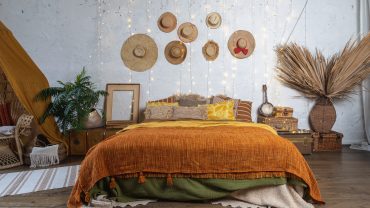What is shabby chic interior design? In a nutshell, it’s a unique blend of styles that often combines vintage and upcycled furniture with distressed finishes. It features layers of floral textiles, antique fixtures like chandeliers, and a palette of soft, neutral colours. It also incorporates elements of Bohemian decor, French country aesthetics, and the Cottagecore theme. In this guide, we’ll delve into how these elements come together to define modern shabby chic decor, providing you with both insights and creative ideas to infuse your home with this elegantly timeless and cosy aesthetic.
It’s fair to say that interior shabby chic is more than just a design style or an aesthetic choice. It’s a whimsically wonderful way of expressing individuality, personality and authenticity.
So, whether you’re looking for cosy, comforting creativity for your cottage, or you want to bring a touch of nostalgia to a new-build, let’s find out the answer to the question ‘what is shabby chic interior design?’
Perfectly Imperfect: A Short History of Shabby Chic Interior Design

A living room decorated in a Shabby Chic style. (Credit: Dana Hoff via Getty Images)
In one form or another, the shabby chic design style has been around for centuries, but its modern incarnation can be traced back to the large, country houses of Britain, where worn and faded furnishings were a common sight. From there, the idea that furniture and furnishings didn’t have to be brand new to be aesthetically pleasing took on a life of its own.
Origin Story
It’s believed the phrase itself was coined by british-born designer Rachel Ashwell, who opened a shop in Santa Monica in California in 1989 called ‘Shabby Chic’, selling slipcovers and flea market furniture. She described the style as ‘the aura of old money, cushy comfort, and crafted indifference.’
Her vision of bringing new life to old, forgotten items resonated, sparking a design movement that celebrated the elegance of aged beauty. This philosophy stood in contrast to the then-prevailing trends of modernism and minimalism, offering a more personalised and romantic approach to interior decorating.
The Principles of the Shabby Chic Design Style

A shabby chic interior designed bedroom. (Credit: Westend61 via Getty Images)
At the heart of creating an interior shabby chic look are several key principles. Firstly, it emphasises the use of antique, vintage or vintage-looking pieces, often with a distressed or weathered finish, to evoke a sense of history and nostalgia. The style leans towards a soft and elegant feel, featuring light colours, floral patterns, and delicate textures.
Yet it’s not just about the visual appeal. Shabby chic interior design is also about creating a comfortable, lived-in space that feels welcoming and unpretentious. This approach to design encourages a creative mix of old and new, seamlessly blending different eras and styles.
The Shabby Chic Colour Palette

Shabby Chic colour palette (Credit: Artur Debat via Getty Images)
The colour palette of modern shabby chic decor is quintessentially soft and muted, evoking a sense of calm and understated elegance. Central to this palette are shades of white and cream, which serve as a versatile base, creating a light and airy feel in any space.
These neutral tones are often complemented with pastels like dusty pink, serene blue, and soft green, adding a touch of colour while maintaining the overall delicacy of the scheme. This gentle approach to colour is pivotal in achieving the shabby chic look, as it sets a tranquil backdrop which allows the vintage elements and textures to stand out.
Accentuating these soft hues are occasional touches of brighter or deeper colours that add depth and interest. A pop of rose red or sage green can bring warmth and life to your room without upsetting the balance. Floral patterns play a significant role, adding a romantic and whimsical charm, however the goal of the shabby chic design style is to create a harmonious and inviting atmosphere, where colours blend seamlessly for a cosy and nostalgic feel.
Shabby Chic Furniture

Typical decor for a shabby chic living room (Credit: Olena Ruban via Getty Images)
The furniture that embodies shabby chic interior design is characterised by its gracefully aged appearance, often featuring pieces that are distressed or have a weathered patina. This style embraces furniture and furnishings with a story, highlighting items that show signs of wear and tear, like chipped paint or exposed wood. Vintage or antique pieces are common, with a preference for items that have a delicate feel. It often includes ornate detailing, such as carved woodwork or elegant curves, adding to the romantic and nostalgic ambiance of the space.
In addition to its aged look, shabby chic furniture is often painted in white or pastel hues, aligning with the style’s overall colour scheme. This includes large pieces like armoires, dressers, and dining tables, as well as accents like side tables and chairs. The paint is sometimes deliberately distressed to enhance the rustic charm. Upholstered pieces are typically covered in soft, plush fabrics, often with floral patterns or in solid, muted colours, to complement the gentle and inviting atmosphere.
Time-Worn Elegance: Shabby Chic Interior Design

Hallway, featuring shabby chic design. (Credit: Sebastian Condrea via Getty Images)
The shabby chic design style offers a unique blend of elegance and comfort, bringing together elements of the past to create a warm and inviting present.
This style celebrates the beauty of ageing and imperfection, incorporating vintage and distressed pieces with soft, muted colours to create spaces that feel both romantic and homey. It’s a testament to the charm of simplicity and the grace of time-worn objects, inviting us to embrace a more relaxed and personal approach to decorating our homes.
Whether you’re a seasoned decorator or a beginner, incorporating modern shabby chic decor can transform your space into a cosy, timeless sanctuary.












